 UNITED KINGDOM: Judicial and Prison CP
UNITED KINGDOM: Judicial and Prison CP
On this page:
Up to the mid-19th century
The modern era
JCP for boys under 16 in modern times
JCP for men in modern times (England and Wales only)
CP for internal prison offences
Equipment used: adults
Equipment used: juveniles - England and Wales
Equipment used: juveniles - Scotland
Moves to reintroduce JCP
Documents
External links
Corporal punishment by order of the courts was abolished by statute in 1948 in mainland Britain.(1) It had once been fairly common. By the early 20th century its use had been reduced drastically for adult men, but it was still sometimes ordered for robbery with violence. Meanwhile, boy thieves were still sentenced by local courts to the birch (and, in Scotland, also to the tawse) in many areas.
(1) But not in Northern Ireland or in the offshore Crown Dependencies such as the Isle of Man.
Up to the mid-19th century
Until the mid-Victorian era, under common law derived essentially from mediaeval practice, offenders could be "whipped" for a wide range of crimes, without either the implement to be used, or the number of strokes, being specified. No rules appear to have been laid down as to the modus operandi. In practice, it seems generally to have been done with a whip of some kind, typically to the upper back, and sometimes in public.
The whipping of females, as in this March 1817 case, was abolished in 1820 (1 Geo. IV. c. 57), and public flogging ceased in the 1830s. The public whipping briefly noted in this 1831 account must have been one of the last in London. A slightly fuller account of such a public "whipping at the cart's tail", this time in Glasgow, is given in this 1822 report. For an earlier and more famous example, see these 1685 news items.
The modern era
Under various legislation between 1861 and 1863, provision for JCP was restricted and regularised by statute law. Ordinary local courts lost their common-law right to order whippings. Now, only the higher courts in England and Wales were empowered to mete out corporal punishment for adults, and only for a narrowly defined range of offences -- mostly robbery with violence, but also treason (almost never invoked in practice), vagrancy, and certain "vice"-related crimes such as "living off immoral earnings" and importuning.
The court was now required to specify the use of either the birch or the cat-o'-nine-tails, and to stipulate how many strokes were to be delivered. The cat could be ordered only for offenders aged over 16; the birch was applicable at any age. These punishments were almost always combined with a term of imprisonment, and were carried out privately in prison. The birch, traditionally a punishment for boys and youths since Roman times, was administered to the bare buttocks. The cat-o'-nine-tails, previously more familiar in a military or naval setting, was applied to the bare upper back.
The 1860s legislative changes heralded what can now be seen as the heyday of formal JCP, lasting for over half a century until the end of World War I. This March 1869 news item describes what was said to be "the first flogging of adults in Newcastle gaol". For a time, newspaper reporters were allowed into the prison to observe these events: see also for instance this 1878 case.
All this applied only to England and Wales. In Scotland, JCP for adults was never prescribed by legislation for robbery but only for one or two prostitution-related offences, very rarely invoked in practice, so it can be regarded as having been all but abolished there in 1862.
At around the same time, increasing revulsion against the idea of incarcerating youngsters in prison led to a more systematic application of corporal punishment, in lieu of imprisonment, for male juvenile offenders, in Scotland as well as in England and Wales.
JCP for boys under 16 in modern times
Judicial CP of male juveniles was much less severe, and much more common, than that of adult men. There were 4,116 cases in 1900 and 6,135 cases in 1917. It went into a sharp decline after World War I, but there were still well over 400 birchings as late as 1935. Unlike adult JCP, from 1847 onwards it could be ordered by ordinary local magistrates for various offences, but in practice nearly always for petty larceny (stealing).
To begin with, this punishment could be given with any instrument locally deemed suitable, usually in prison -- see this Jan 1851 news item. See also these prison mugshots of seven boys aged 11 to 14 who received court-ordered birchings at Wandsworth Prison in London around 1873.
But from 1879, when these matters became more centrally regulated, it took the form of an immediate birching by a policeman, in the nearest police station or sometimes in the court building itself. This was seen as a relatively minor punishment and a humane alternative to imprisonment. The birch used was smaller and lighter than the ones supplied to prisons for use on adults. It was an implement with which many legislators would have been familiar from their schooldays.
These sentences were not always covered in the press, especially in the big cities, where cases in local magistrates' courts (often called "Police courts" in those days) were frequently seen as too trivial to be worth reporting. But many were reported, and this March 1886 case and this Aug 1917 case are probably fairly typical.
In England and Wales this power of ordering JCP applied only to boys up to age 14, but in Scotland the upper age limit was 16. Also, in Scotland only, the court could specify the use of a leather tawse instead of the birch, for culprits between 14 and 16. The tawse was seen as the more severe instrument; like the birch, it was applied to the boy's bare posterior. Remarkably, the maximum penalty in Scotland for boys between 14 and 16, right up until abolition, was 36 strokes (with either implement). For boys under 14 in Scotland the maximum was twelve. In England and Wales, from 1862 onwards, the maximum for boys under 14 was 12 strokes, and after 1908 only six.
Cadogan (1938) asserts that the tawse had largely fallen into disuse by the time of its investigation and that the Scottish courts now mostly ordered only the birch.
Over the years there were many proposals to extend England and Wales magistrates' powers to include the birching of youths older than 14 and for a wider range of offences, bringing the position more into line with that in Scotland: see for instance this 1884 newspaper editorial. None of these attempts ever made it on to the statute book, despite a feeling in some quarters that it was precisely older teen offenders who could most benefit from receiving a whipping instead of being locked up. A case in point was the Youthful Offenders Bill of 1900, which passed several parliamentary stages before running out of legislative time in the House of Commons.
Higher courts in England and Wales, typically the Quarter Sessions or Assizes in each county, could still order birching for boys over 14 who were too old to be punished thus by magistrates. This was much less common, and usually more severe in terms of number of strokes (up to 25 were permitted). These birchings were generally combined with a term of imprisonment and were carried out in prison, like adult ones.
JCP for adult men in modern times (England and Wales only)
From the early 1860s onwards, only higher courts, not local magistrates, could order corporal punishment for males over 14. The court was required to specify the instrument to be used, either the cat-o'-nine-tails (for offenders over 16) or the birch (for any age). The punishment was always carried out in prison.
The cat was applied to the prisoner's upper back as he stood upright. The birch was administered to the unclothed seat with the recipient secured in a bending-over position; this was thought by some, though not always by prisoners themselves, to be less severe than the cat in terms of pain, albeit more shameful because of the enforced baring of buttocks and/or because birching had traditionally been a schoolboy's punishment.
For whatever reason, maybe simply as a result of arbitrarily fluctuating judicial fashion, the birch was hardly used at all on adults at first, but was later to become much more commonly used than the cat for robbers in their teens and twenties. JCP cases reported in 1866 and 1867 and 1869 and 1871 all involved the application of the cat-o'-nine-tails. This 1872 report of a prosecution in the Central Criminal Court in London contains one of the earliest references to the birch being specifically stipulated for an offender over 16 -- a very rare treason case, involving a youth who pointed a pistol at the Queen.
According to this news report, in 1903 there were 16 sentences of adult JCP, 14 with the cat and two with the birch.
In this Oct 1930 court case, the judge sentenced men aged 20 and 22 to birching, stating that he "hesitated to order the cat for such young men", implying perhaps that he thought the cat was more brutalising, something to be used only on hardened old lags. Similarly, the judge in a 1943 case ordered a 19-year-old to be birched, saying that "if he had been a little older he would have ordered the cat".
A counter-example is provided, less typically I think, by this case of a 23-year-old gunman being ordered to receive the cat as late as 1947, one of its very last uses in the UK as a judicial penalty.
All these cases were for robbery with violence, in practice almost the only offence for which JCP was ordered for adults in relatively modern times. However, adult JCP of any sort was a fairly rare event throughout the 20th century: in the last 20 years before abolition in 1948, the annual number of cases was rarely more than two dozen for the whole of England and Wales, apart from an upward blip in 1932 (61 cases) and 1933 (42 cases). These latter were partly due to Sir Ernest Wild, Recorder at the Central Criminal Court in London, who went on something of a birching spree against young robbers in the late 1920s and early 1930s -- see this June 1929 report and other examples in Sep 1929 and Dec 1930 and Oct 1931 and these Nov 1932 cases and these April 1933 cases.
CP for internal prison offences
The 1948 abolition did not affect the ability of a prison's visiting justices (in England and Wales, but not in Scotland, except at Peterhead) to order the birch or cat for prisoners committing serious assaults on prison staff. This power was not abolished until 1967, having been last used in 1962. In the 1950s there had been perhaps three or four such punishments per year on average -- see for instance these July 1954 press reports and this Sep 1957 item. Each such order had to be approved personally by the Home Secretary (interior minister of the government) in London before being carried out -- something successive Home Secretaries, irrespective of the party in government, became increasingly disinclined to do, much to the chagrin of the Prison Officers' Association, this Nov 1966 example being one of the last such failed cases before the power was abolished altogether.
This requirement for central government approval of each individual prison flogging was not always pleasing to the Visiting Committees (the local magistrates appointed to adjudicate on such matters at each prison), who sometimes felt they should have the power to flog prisoners without higher approval, as noted in this Jan 1901 news item.
For what is believed to be the last actual use of prison discipline CP (and hence the last adult birching of any sort in mainland Britain), see this May 1962 report that a 33-year-old, pictured, had received 15 strokes of the birch at Hull prison. The news item stresses he received the punishment "on his backside" and, intriguingly, claims the Home Office stated that this was "designed to reduce the stature of the prisoner to that of a naughty boy" -- although, as far as we know, the only naughty boys still being birched in the UK by 1962 were at Eton College, and even there only for a couple more years or so.
Equipment used: adults
The birch, officially known misleadingly as the "birch rod", was a bundle of twigs bound together at one end to form a handle. Birches came in three sizes for different ages, stipulated in detail in legislation. The adult (over-16) birch was 48 inches long and weighed 12 ounces.

Click to enlarge |
Shown at right is a "senior birch, for males over 16" exhibited at Dartmoor Prison Museum. This ought to be 48 inches long overall, with a handle of 22 inches, but we can see that the handle is longer than the spray part, so the business end must have partly disintegrated, as is the norm with birches in museums. The spray should be longer and more bushy -- see examples in the Wormwood Scrubs picture, further down this page. The museum staff have added the following remarkable text to the label after the information about the weight and dimensions:
It is all very well defining the finer points of implement manufacture but it is in the use lies [sic] the proof of the pudding.
Just to ensure the whole process involving the birch was satisfying for all involved (excepting one!) officers who had used the implement left advice for those who came after:
"Use of Birch: Hit as hard as possible, and as the birch lands always pull the birch and the smashed [?] ends will cut the flesh a lot better."
Such commendable dedication to professional performance!
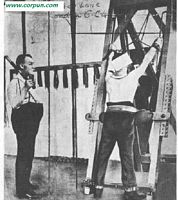
Click to enlarge |
The cat-o'-nine-tails had a total weight of 9 ounces. The nine "tails" were of fine whipcord, each 33 inches long and bound with silk at the tip. These were attached to a 19-inch handle. Contrary to popular myth, they were not knotted or weighted. The instruments were manufactured centrally and distributed to prisons by the Home Office.
This (left) is believed to be the only official picture ever published of a (possibly posed) flogging with the cat-o'-nine-tails in a British prison. This might be either as a judicial sentence by a court (in addition to a prison term) or as a punishment for a very serious breach of internal prison discipline; the procedure in the two cases was identical. I believe the picture was authorised by Winston Churchill as Home Secretary of the day, which fixes the date at 1910 or 1911. Just visible is the cat itself, no doubt the "real thing" where other pictures may not be authentic. Most regrettably, there is no known picture of a real-life birching.
The design of the punishment furniture used in prisons varied over time. That used by the police for juvenile birchings also varied from place to place, since there was no centrally imposed standard for the modus operandi, and it was left to local police forces to use their initiative.
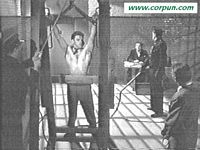
Click to enlarge |
The picture at right is a still from a 1948 film noir called "Kiss the Blood off my Hands" about an American (Burt Lancaster) who falls into crime in London. Compare with the real thing, above. The frame appears to have been reproduced very precisely. This view gives a clearer impression of the hoist-and-pulley system keeping the prisoner's arms stretched up. However, the instrument used is too big altogether and looks more like an ordinary whip. Perhaps the makers of the film did not think the real thing looked scary enough: it was a surprisingly small and lightweight implement, according to this article by a retired police chief in a tabloid paper of 1954, by which time CP could no longer be ordered by the courts but was still occasionally used for prison disciplinary offences involving serious violence.
about an American (Burt Lancaster) who falls into crime in London. Compare with the real thing, above. The frame appears to have been reproduced very precisely. This view gives a clearer impression of the hoist-and-pulley system keeping the prisoner's arms stretched up. However, the instrument used is too big altogether and looks more like an ordinary whip. Perhaps the makers of the film did not think the real thing looked scary enough: it was a surprisingly small and lightweight implement, according to this article by a retired police chief in a tabloid paper of 1954, by which time CP could no longer be ordered by the courts but was still occasionally used for prison disciplinary offences involving serious violence.
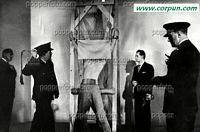
Click to enlarge |
At left is an agency photo captioned "A flogging taking place with the prisoner strapped up and a doctor in attendance to monitor events, 1958". The frame is broadly similar to those used in UK prisons (see above). But prison floggings were extremely unusual by 1958 (the last ever was in 1962), and anyway this picture looks unreal to me. The men have a look of being actors. The scene has been lit from the side (note shadows) as in a "film noir" or a cheap 1950s police thriller movie.
On balance, I think this looks more like a stage set at Ealing or Pinewood than a real room in a prison (and this would not be the first time a picture agency has mistaken a scene from a fictional film for the real thing). I wonder if a prison officer carrying out a flogging in real life would have been all that likely to keep his uniform jacket and hat on while doing it. However, the kidney-protecting belt seems right, and it is true (according to Cadogan) that a canvas sheet was used, possibly as shown here, to hide the identity of the flogging officer from the prisoner.
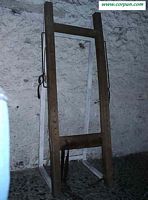 Click to enlarge |
Beaumaris Gaol was on the island of Anglesey (North Wales) and is now a museum . This (right) is a very simple A-frame. The prison closed in 1878, so this is quite an early example, possibly from before practice in these matters became at all standardised. It appears to have been designed only for standing up at, with no apparent provision for a bending-over position, and I think it would have been meant for floggings with a whip or cat on the prisoner's upper back. Note the leather straps to secure his legs and arms. The small holes on either side of the middle front would have been for a crossbar of adjustable height, as in the "Churchill" picture above, but the crossbar itself has gone.
. This (right) is a very simple A-frame. The prison closed in 1878, so this is quite an early example, possibly from before practice in these matters became at all standardised. It appears to have been designed only for standing up at, with no apparent provision for a bending-over position, and I think it would have been meant for floggings with a whip or cat on the prisoner's upper back. Note the leather straps to secure his legs and arms. The small holes on either side of the middle front would have been for a crossbar of adjustable height, as in the "Churchill" picture above, but the crossbar itself has gone.
Beaumaris was a very small prison -- about 30 prisoners in the 1870s -- in a very small place, and this contraption saw little or no use in its latter years.
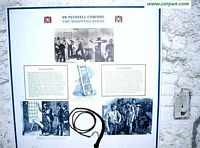 Click to enlarge |
According to the parliamentary returns, the only corporal punishments inflicted in Beaumaris between 1858 and 1878 were four magistrates' birchings of boys aged 11 to 14 for petty larceny. I suspect this frame would not have been used for those.
The museum's wall display "The Whipping Room" (left) shows some very familiar illustrations, none of them anything to do with Beaumaris, and a picture of what looks more like a cattle whip than the cat-o'-nine-tails that was probably used in fact. I have no transcript of the text, but I slightly doubt that it tells us anything we do not already know.
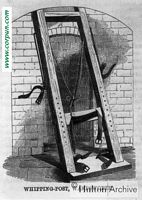 Click to enlarge |
Wandsworth was (still is) a prison in London. It was the central base from which birches and cats were supplied to prisons throughout the country. It also had a Borstal wing, and it was at Wandsworth that most Borstal birchings (of which there were never very many) were carried out, according to Cadogan. This inept drawing (right) has appeared in various books. It may originally have been done for one of the more sensational newspapers in, at a guess, the latter part of the 19th century, and I would not be at all confident about its authenticity. For what it may be worth, the device -- a frame and not, as captioned, a post -- appears to be designed to hold the prisoner in an upright position, which probably means that it would be intended solely for the application of the cat to the upper back.
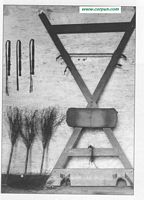 Click to enlarge |
This picture (left), supposedly from Wormwood Scrubs prison in London, has been widely reproduced. I think it probably dates from 100 years ago or more. The frame is clearly only for a recipient who is standing upright, and yet birches are shown (lower left) as well as cats-o'-nine-tails (upper left). Presumably the birches were not for use with this particular piece of equipment. At all events, this seems to be a rare picture of real birches photographed when they were still in use, not falling to pieces in a museum.
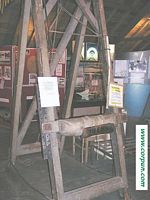 Click to enlarge |
This (right) is on display at Dartmoor Prison Museum. The padded bar at the front, over which the prisoner would have been bent for a birching, can be moved up or down to suit his height. The extra padding would presumably be to cushion his genitals. This wooden A-frame is obviously a completely different device from the metal Dartmoor triangle shown in 1894 official drawings. So if this really was used in Dartmoor, a change was evidently made at some later date. Alternatively, maybe this frame came to the museum from some other prison: it is clear from some of the other exhibits that not everything shown is originally from Dartmoor.
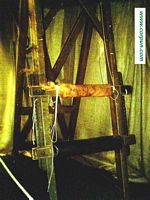 Click to enlarge |
This triangle (right), allegedly used from 1935 to 1961 at Wandsworth prison (see earlier item), is on display at the Galleries of Justice museum in Nottingham. It is similar to the Dartmoor frame, above, but has an extra bar at chest level, for use when the prisoner is standing upright for a flogging with the cat on the upper back.
Below are draughtsman's drawings for the above frame, also on show at the Nottingham museum, and the museum's captions for the display. I am not sure about the accuracy of the text. I should be surprised if floggings were performed in front of other prisoners in modern times. The author seems not to be aware that this would have been used for judicial CP as well as prison discipline floggings.
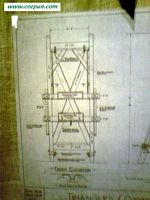 Click to enlarge |
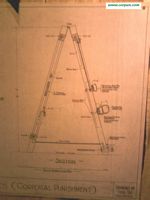 Click to enlarge |
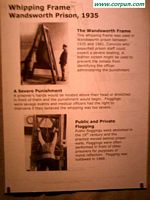 Click to enlarge |
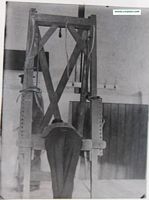 Click to enlarge |
The pictures at right and below, found in local archives (LMA ACC/3444/PH/01/019), were taken around 1930 in Wandsworth Prison. A prison staff member acts as the "dummy" to test the design and construction of a new A-frame, to be used both for birching (prisoner bending over) and flogging with the cat (prisoner standing up straight). This appears to be the same contraption as is now on show in Nottingham (see above).
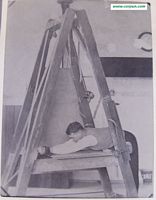 Click to enlarge |
The first two pictures show the device in birching mode, where the prisoner was made to bend over the padded bar, with his upper body flat along the horizontal platform. The wrists are secured at the far side, the ankles are shackled together (out of shot in these pictures), and there is a leather belt over the small of the back to cover the kidneys. (In these respects, the procedure is almost identical to present-day practice for caning in Singapore.) A canvas sheet attached to one side of the frame prevents the prisoner from seeing who is wielding the birch. In reality the prisoner's posterior would be uncovered before he bent over. According to some accounts, this was accomplished by having him remove his trousers and underwear altogether.
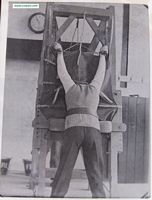 Click to enlarge |
One may suppose that this very equipment was probably used for the infliction of, for instance, these 1932 London judicial birchings (these are examples of 35 birchings for robbery with violence ordered by the Central Criminal Court in 1932, accounting for more than half the total instances of non-juvenile JCP for England and Wales in that year). For a more recent example, see this 1946 case.
In the third photo, the "model" is pretending to be a prisoner rigged up for punishment with the "cat" on the upper back. His head goes through a hole in the canvas sheet to stop him from seeing who is behind him. In reality the prisoner would be stripped to the waist, but he kept his trousers on.
Note that, for birching, the prisoner's legs are kept together to protect the back of the genitals from being struck accidentally, while for flogging with the cat the legs are held apart for stability. Flogging with the cat was becoming quite rare by this period, at any rate for court-ordered CP, so this very solid and impressive frame would mainly have been used for birching across the buttocks. From press reports of court cases, it is clear that such punishment was overwhelmingly of offenders in the age range 16 to 25.
Equipment used: juveniles - England and Wales
For boys under 10, the birch was 34 inches long with a weight of 6 ounces. For boys aged between 10 and 16, the instrument was 40 inches long overall and weighed 9 ounces. These dimensions compare with 48 inches (12 ounces) for the adult birch.
It was left to the police in each area to devise methods of birching juveniles sentenced by local magistrates. There was no standard pattern imposed by central government. Consequently, procedures and equipment varied from one place to another.
It should be noted that, according to Cadogan, in some districts the recipient was not secured to any device:
"The method most commonly adopted is to bend the boy over a low bench or table. His hands, and sometimes his feet also, are held by police officers. This is done in order to ensure that he shall not move [...] In some Police Forces one constable takes the boy on his back, drawing the boy's hands down over his shoulders; another constable holds the boy's feet, drawing his legs round the sides of the first constable; the first constable then leans forward, and the birch is applied by a third."
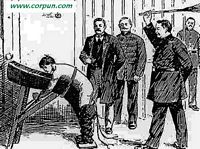 Click to enlarge |
This drawing (right), source unknown, seems broadly to accord with much of what one has read about judicial birchings of juveniles by the police. The boy's trousers have been lowered but not removed. The pony here is not altogether unlike the one in the photo (next item) and gives an idea how it would have been used. With this kind of pony the boy's position could be described as leaning rather than bending, so his buttocks are not so well presented as in some other versions, but there is no doubt that they are none the less the sole target of the operation. A gently curving pony of this type possibly had the advantage that it would work reasonably well with boys of widely varying heights. Note the doctor in a frock coat, monitoring the proceedings. This was by no means always the case in reality, according to the Cadogan Report.
A fairly plausible reconstruction of such a birching is shown in episode 1 of the BBC TV drama series The Monocled Mutineer (1986), set in 1908 and based on real events.
(1986), set in 1908 and based on real events.
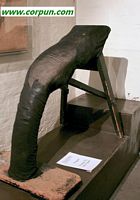 Click to enlarge |
Here (left) is a birching pony broadly similar to that shown in the drawing above, differing only in detailed design, which was on display at the Manchester Police Museum. The lad being disciplined had to stand with his feet either side of the narrower part at the bottom.
It appears to have seen plenty of use! Note how worn-out is the part where the boy's torso would have been pressed against it.
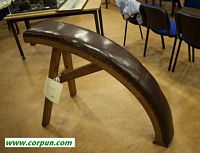 Click to enlarge
|
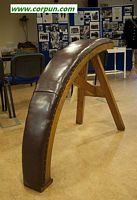 Click to enlarge |
Similar in concept to the above but different in detail is this birching pony (right) originally from Sunderland police station, displayed in the Beamish Museum in County Durham. The leather top shows no signs of wear and tear, so perhaps this one has been restored.
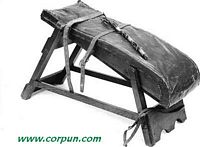 Click to enlarge |
This rather elaborate, leather-upholstered contraption (left) is said to have been used in the West Midlands. The top measures 45 inches long (114 cm). Compare it with the London and Nottingham versions. The birch shown here consists largely of the handle alone, the business end having mostly disintegrated. This is what usually happens to birches in museums, giving the general public a misleading idea of what birches really looked like and how big they were.
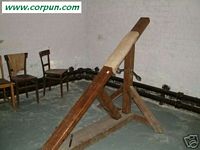
Click to enlarge
|
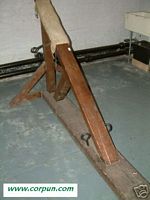
Click to enlarge |
I have never seen a birching bench like this (right) before, which just goes to underline the extent to which different police forces invented their own solutions. This one is said to come from a former police museum in Shropshire. I deduce that the offender had to lie along the diagonal slope with his legs on either side of it, fixed at ankle level with the rings shown, making his bare bottom available for punishment part way up the slope. Presumably the padding at the top end is for his head, and the rings at the far end for his wrists. This design perhaps has the advantage that it would suit a lad of any height. On the other hand, it looks as if it must have been somewhat uncomfortable for the boy, and I should have thought there was a risk that the birch might strike the back of his testicles, unless some special precautions were taken.
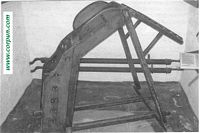
Click to enlarge |
This curious birching pony for boys (left) is in the Prison and Police Museum in Ripon, Yorkshire, originally from the police lock-up in Leeds, where it was allegedly last used in November 1920. Ignore the pipes along the back wall, which confuse the picture a little. The offender would have stood between the two side panels at left, with his upper body at 45 degrees along the top part. Slightly puzzling is the section on the front, at right of picture, which can only have been to secure his arms. The whole thing seems unnecessarily elaborate.
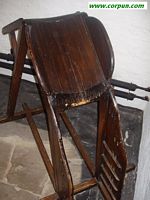
Click to enlarge |
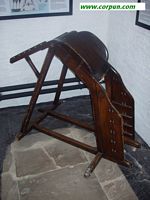
Click to enlarge |
These two pictures (right), in colour, of the above machine give us a clearer view of, particularly, the side panels with slots, which provided for the raising or lowering of a plank on which the boy had to stand, depending on his size. However, in this view the plank itself is missing.
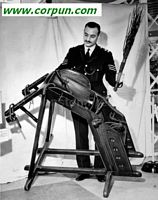
Click to enlarge |
This further and much earlier picture (left) of the same device, from a Yorkshire Post report on a police exhibition in 1967, has now come to hand, complete with policeman wielding a birch. Here we can just see the height-adjustable plank between the slots. Also visible are the various straps to tie the culprit's legs, torso and wrists to the pony.
Equipment used: juveniles - Scotland
Procedures for administering the birch or the tawse in Scotland seem to have differed a little from those in England and Wales. It appears that in many places the recipient was secured lying flat, face down, rather than in a bending position as was the preference in England and Wales.
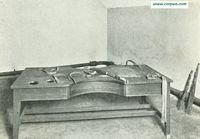
Click to enlarge |
This splendid piece of furniture (right), sadly, apparently now exists only as a photograph in a library in Glasgow. It came in 1909 from the South Prison in the Justiciary Buildings in Saltmarket in that city.
Regulations of 1886 laid down that, since (unlike in England and Wales) there was no right of appeal, the whipping was to be carried out on the day it was ordered. They added that the punishment must be "sufficiently severe to cause a repetition of it to be dreaded".
Courts did not hesitate to use their powers, and records can be found in parliamentary returns for the 1870s of boys being sentenced in Glasgow to "36 strokes on the breech with a leather taws" [sic]. A gradual decline set in after the turn of the 20th century. According to the Cadogan Report (1938), there were 731 juvenile whippings in Scotland in 1900, 562 in 1915, and 230 in 1930. By that time, says Cadogan, the tawse was very rarely ordered, and nearly all JCP was with the birch.
The culprit would be made to lie face down along the table with his head at the left end as seen in this view, and his arms put through one or other set of holes, depending on his size. His genitals are positioned over the padded section to cushion them against being crushed, and the padding would also have the advantage of raising up his buttocks slightly. The straps are used to fix his torso and thighs securely to the bench. His lower legs and feet would stick out over the right-hand end of the apparatus.
On top of the bench lies a birch; two more birches, of differing sizes for different age groups, are leaning against the wall at right. Hanging off the right-hand end is a tawse.
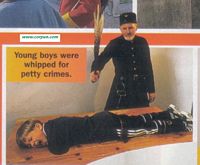
Click to enlarge |
Somewhat similar to the above, but of a rather more basic design, this whipping table (left) is at Inveraray Jail museum in Argyll , in the Scottish highlands. Youngsters visiting the museum can "feel what it is like to be strapped to the Whipping Table". The picture is from the museum's brochure; of course the boy in reality would have had his trousers pulled down, but at least the birch is shown being applied to the correct part of the offender's anatomy. The picture does, anyway, illustrate how the "arms through holes" system would have worked.
, in the Scottish highlands. Youngsters visiting the museum can "feel what it is like to be strapped to the Whipping Table". The picture is from the museum's brochure; of course the boy in reality would have had his trousers pulled down, but at least the birch is shown being applied to the correct part of the offender's anatomy. The picture does, anyway, illustrate how the "arms through holes" system would have worked.
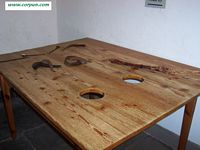
Click to enlarge |
This (right) is a clearer picture of the birching table at the Inveraray Jail museum. Note holes for the boy's arms and straps for his legs and feet. The remains of a birch are seen lying on the table.
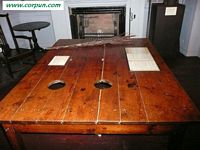
Click to enlarge |
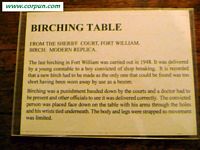
Click to enlarge |
Very similar to the above, this one (left) is at the West Highland Museum in Fort William. The notice says that the last birching in the town was in 1948, in fact the last year when it was legally possible and by which time juvenile birchings were rather rare, even in Scotland. The birch shown is described as a modern replica.
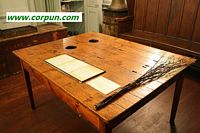
Click to enlarge
|
At right is another view of the Fort William birching table.
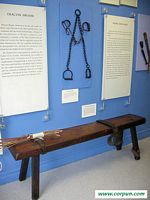
Click to enlarge |
The Cadogan report informs us that in some parts of Scotland it was common for juveniles to be laid flat on a simple bench to be birched, in contrast to the more elaborate contraptions used elsewhere. This birching bench (left), with the remains of a birch sitting at one end of it, was found in the Edinburgh Police Museum.
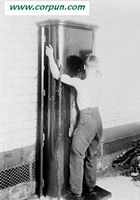
Click to enlarge |
The picture at right was in a museum in Glasgow. This strange "flogging stand" looks to have been adapted from a domestic wardrobe. It is difficult to see otherwise why it would be made of polished wood or have an elaborate cornice at the top. At all events, the picture is highly misleading in showing the lad stripped down TO the waist, implying that the punishment was applied to the upper back. He should be stripped FROM the waist down: juvenile police court birchings and tawsings in Scotland were always administered across the offender's unclothed seat. Note padding on the front of the thing to cushion the boy's abdomen. That in itself suggests that the impact was intended to be at a level somewhat lower than his shoulders.
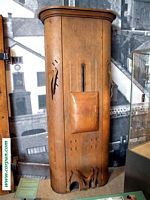 Click to enlarge Click to enlarge |
From another museum, the Summerlee Museum in Coatbridge, this (left) is clearly the same piece of furniture, described as dating from 1890. The slots for the knee-straps can be seen, but the straps themselves are missing. The leather pad can be moved up and down in its slot according to the size of the culprit. Note also the holes at base for the feet.
 Click to enlarge Click to enlarge |
I am greatly indebted to Harold A. Hoff for this rare picture (right) of an actual Scottish judicial tawse, produced for government use some time between 1910 and 1936 (see King George V royal crown stamp). It would have been applied across the bare backsides of boys aged 14 to 16, up to 36 strokes according to the order of the sentencing court. The instrument is over 21" long, rather bigger than the typical school tawse.
Moves to reintroduce JCP
Almost as soon as judicial birching and flogging had been abolished in 1948 began calls for its reintroduction. Judges and newspaper editorialists and members of the clergy were loudly bemoaning the abolition. "Bring back the birch" became a clamour from the early 1950s during what was then perceived to be a crime wave. Among those leading this campaign was no less a figure than the Lord Chief Justice. A parliamentary Bill to this effect, defeated in 1953, was to be only one of many over the decades.
In 1954, the people who run post offices called for the return of the cat. Some backbench Tory parliamentarians repeatedly rebelled against their own party's government to demand the restoration of birching in 1956 and again in 1960, at which point the government went so far as to publish an updated edition of the 1938 Cadogan Report to bolster the case against CP. In 1961 another Lord Chief Justice echoed his predecessor's support. And so it went on. Further backbench attempts at reintroduction were made as recently as the 1990s (see External Links, below) but by that time it was a hopeless cause. JCP remained abolished.
DOCUMENTS:
The Cadogan Report 1938, Part I
This, officially "Report of the Departmental Committee on Corporal Punishment", is the key document on British JCP. Its proposals for abolition were implemented ten years later. This first part, called Historical Introduction, sets out the evolution of the relevant legal provisions.
UPDATE: The entire report is now online at the National Archives, preceded by a Cabinet Paper on the subject (June 1938).
Birches and Cats-o'-nine-tails
Official circular to prison governors in 1951 giving instructions on the ordering, stocking and disposal of whipping implements.
The birching of adult men for robbery with violence
Research by "Diogenes" on a gradual change from cat to birch in the early 20th century.
Whip hand of the state
Feature in Glasgow Herald on juvenile birching in Scotland before 1948.
Flogging triangles
Official diagrams, dated 1894, showing the contraptions used in two English prisons for securing prisoners to be flogged with the cat or birch.
Corporal Punishment in Northern Ireland
In considering British legal matters, the existence within the UK since 1922 of a semi-autonomous jurisdiction for the statelet ("Province") of Northern Ireland, with its own local parliament and laws, is generally overlooked. This 1956 article from a law journal reminds us that Northern Ireland did not follow the rest of the UK in abolishing JCP in 1948, and reveals that the penalty was available for a much wider range of offences than on the mainland. Little-known statistics on the incidence of CP are quoted, from which it is apparent that in practice the penalty was never actually applied in the post-war era as far as adults were concerned. It is not clear whether or not there were any juvenile birchings in the period in question.
Corporal punishment as an internal prison disciplinary measure is also considered. Intriguingly, it turns out that the N.I. legislation provided for the use of the cane (and not only for juveniles) as an alternative to the birch and the "cat" for prison offences -- something never seen in the rest of the UK -- though it seems this was rarely if ever invoked in practice.
EXTERNAL LINKS: (these will open in a new window) 
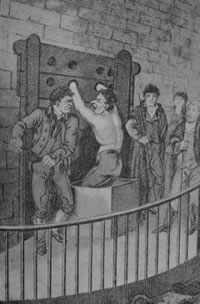 Punishments at the Old Bailey
Punishments at the Old Bailey
The Old Bailey was (still is) the main criminal court in central London. According to this, whipping sentences in the 18th century were mainly for petty larceny (stealing items valued at less than one shilling). After about 1720 these offences were more often punished by transportation (e.g. to Australia). From about the same time, the court began to distinguish between public whippings (carried out in the street, traditionally while being trundled along behind a horse and cart) and private whippings (done inside the court or a jail). Private whippings increased after 1772 owing to a loss of faith in the effectiveness of transportation as a punishment.
A new piece of information is that journalists were allowed to be present at private whippings in the 19th century; it is not stated when this ceased to be the case.
There is a very small reproduction of a 1670s engraving entitled "The Manner of Whipping at the Carts Tayle for petty Larceny and other Offences", and this one (right) from 1809 called "Flogging at the Old Bailey", depicting a private whipping. Public whipping ended in the early 1830s.
You can also search the Proceedings of the Old Bailey, not as its name suggests an official record but a privately published newspaper giving details of some of the more interesting trials from 1674 to 1913. If you search for cases that resulted in whipping you get 5,973 results. You can even access an image of the original page in each case. Note that until the 1860s the courts did not specify a number of strokes or an implement, they just said "to be whipped". From then on, all the JCP cases appear to be floggings with the cat, except for juveniles (relatively rare at this level), who were birched.
"Give him a doing": The birching of young offenders in Scotland
An excellent research paper in the Canadian Journal of History (Dec 2002). Even I, who have been studying this subject for decades, found some new references and fresh insights here.
The subtitle is slightly misleading: a better one would be "the birching of young offenders in the UK, with particular reference to Scotland". The legal systems were (still are) different, but the underlying cultural, social and political issues apply also to England and Wales, and most of the differences are only of degree. I am not persuaded that there was really a distinctly Scottish dimension to the debate.
It is true that by the 1930s the courts in Scotland were ordering a lot more birchings, pro rata to the population, than their counterparts in England and Wales but, even so, Cadogan (1938) notes that there were still a non-negligible 192 cases south of the border in 1935 (for 231 in Scotland).
The author omits to mention the differences in law between the two jurisdictions, the most important of which is that magistrates in England and Wales could not order boys over 14 to be birched, while the equivalent age in Scotland was 16. Since it is precisely boys of 14 and 15 who have generally tended through the ages to be the most behaviourally difficult, this fact alone could account for much of the difference in numbers. Two other differences were that in Scotland there was no right of appeal as there was in England and Wales; and that whereas in England and Wales magistrates could birch only for indictable offences, in Scotland the courts could birch for common-law offences as well -- in practice, for any and every offence.
The author starts by looking at how and why juvenile birching began to come into its own in the middle of the 19th century. It has often been commented that a prime motive was the desire, humanitarian as well as pragmatic, to keep youngsters out of prison or other institutions which were, then as now, cesspits of moral turpitude and "universities of crime". (I wonder if this argument has not been overdone: it seems clear from the Old Bailey proceedings -- see previous item -- that in earlier periods there had been plenty of judicial whippings for minor offences, of children as well as adults, sometimes with imprisonment as well but often without.)
But this paper also draws out another aspect -- the Victorian-era notion that adolescent boys were desperate above all else to think of themselves as "grown-up", that this was a key factor in their offending, and that one good way of persuading them otherwise was by giving them what was regarded as a boy's punishment. Here I think the author slightly misses the point that it is specifically birching that was thought of as boyish, not CP in general. There had always been floggings on the upper back for culprits of all ages. What made the birch distinctive was that its customers received it on their bare bottoms, as naughty schoolboys had done since Roman times.
There is some interesting material here about the campaign waged against juvenile birching in the 1920s, 1930s and 1940s by the political left, the so-called "labour movement", which liked to think of itself as representing the working classes. (Its naïve praying-in-aid of the Soviet Union, which had in theory abolished all corporal punishment, makes embarrassing reading today.) These people persuaded themselves that there was a social-class aspect to the punishment. Of course this is nonsense: you could say exactly the same about imprisonment or any other penalty. The simple fact is that the working classes supplied the vast majority of offenders. This text quotes a number of counter-examples in which real working-class parents actually pleaded with the courts to birch their sons!
New to me was an eye-witness description of the 1937 birching of a 15-year-old watch-thief in Glasgow, which, says the author, "illustrates the medico-scientific nature of rationally calculated punishment". She attributes this passage to Cadogan, page 215, but must have got her footnotes muddled up; it is nowhere to be found in Cadogan, which, moreover, does not have a page 215. Since it gives an unusually thorough account of the modus operandi, I quote the paragraph here:
"The boy was medically examined ... particular attention was paid to the condition of the heart, the stomach and the pelvis ... While the doctor recorded his findings in a book ... noting the exact time, the boy, already stripped to his undervest and trousers, was made to lie face downwards on a table similar to the couch in a doctor's surgery, but slightly shaped to receive comfortably the shape of the body. Stretched out to the fullest, held by two men, one grasping his hands, the other his feet, the boy was about 3 feet from the floor. The last act of the executioner before administering the rod was to bare the buttocks. The vest was raised to just below the kidneys, the trousers pulled down to the thighs. Standing at a distance of about 4 feet from the table, the bircher ... raised the rod just beyond his head, administered the punishment in a slow measured fashion, allowing about 2 seconds between each blow ... The rod... raised no welts and it was noted that the boy, until the fourth blow gave but little gasps after each stroke and squirmed, but from then onwards he howled."
At a Newgate Flogging
From In Strange Company by James Greenwood (1874). He gives a detailed eyewitness account of the flogging with the cat of a garrotter (robber with violence) in Newgate Prison, London. Evidently accredited reporters were allowed to witness these events in those days, which I think was not the case by the turn of the twentieth century. See also, for instance, this 1867 news item.
Whipping
Entry in the 1911 edition of the Encyclopaedia Britannica. Some 18th-century examples of judicial CP are mentioned. It seems rather odd for a publication in 1911 to be giving the impression that judicial CP was already something confined to the fairly distant past. In fact, it was still in regular use at the time, albeit mostly only for juvenile offenders, whose punishments were legally called "whippings" even though the instrument used was actually the birch. Also, the last line is mistaken in stating that the whipping of females in the UK was abolished in 1791. My information is that this took place in 1820 -- see these 1822 news items (and see also next item).
Corporal punishment
Another entry in the 1911 Britannica (see above). This one confirms that the whipping of women was absolutely prohibited in an Act of 1820. Also summarises the legal situation as at 1911 for JCP in England and Wales.
Rockin' the boat
This article in the London Guardian (May 2002) looks back to the demands in the early 1950s for the restoration of the then recently-abolished birch in the face of what seemed at the time like a crime wave. But these things are all relative, and nowadays the 1950s are thought of as a golden era of unimaginable peace and order.
Criminal Justice Bill, Standing Committee B, 14 February 1961
House of Commons committee debate on an unsuccessful clause to introduce JCP for offenders under 21. This includes a long speech by Mrs Margaret Thatcher, then an obscure backbench MP. She supported the clause, on balance. (She had abandoned this idea, I think on practical grounds rather than on principle, by the time she became Prime Minister 18 years later.)
Corporal Punishment (Re-introduction)
Parliament debate (June 1995) in which Warren Hawksley MP made his third unsuccessful attempt to introduce legislation to restore judicial CP.
New Clause 14: Corporal punishment
Another debate in Parliament, this time in January 1997, with Tony Marlow MP taking over as spokesman for the bring-back-flogging cause.
 Other external links for UK/Judicial CP
Other external links for UK/Judicial CP

